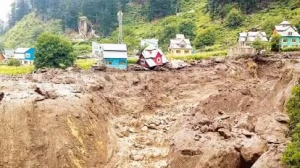GS3 – Disaster management

Contest:
A sudden cloudburst in Chositi, Kishtwar (Jammu & Kashmir) during the Machail Mata pilgrimage around 11:30 a.m on 14 August 2025. triggered a devastating flash flood, leading to over 65 deaths, 300 injuries, and 200 missing persons. Rescue operations by the SDRF, NDRF, Indian Army, and Air Force are ongoing, but efforts have been hampered due to persistent cloud cover.
Definition
- Flash Flood: A sudden and extreme flow of water occurring within 6 hours of a causative event (heavy rainfall, cloudburst, dam break, GLOF, landslide).
- Characterised by rapid onset, high velocity, and destructive force with little or no warning time.
Causes / Triggers
- Meteorological Factors
- Cloudbursts: Very high rainfall (>100 mm/hour) in a localised area.
- Intense Monsoon Showers: Especially in Himalayan states and NE India.
- Geological & Hydrological Factors
- Glacial Lake Outburst Flood (GLOF): Sudden release of water from glacial lakes.
- Landslide Lake Outburst Flood (LLOF).
- River channel blockages and debris flows.
- Anthropogenic Factors
- Deforestation & Land Use Change → loss of natural drainage.
- Urbanisation → concretisation reduces infiltration.
- Encroachment of flood plains.
- Dam/embankment failure.
Impact
- Human Losses: Deaths, injuries, displacement.
- Infrastructure: Damage to roads, bridges, hydropower plants, telecom, railways.
- Agriculture: Crop destruction, livestock mortality.
- Economy: Loss of livelihoods, tourism decline.
- Environment: River morphology changes, soil erosion, landslides, biodiversity loss.
- Governance Challenges: Rescue hampered due to terrain, communication failure.
India – Vulnerable Regions
- Himalayan States: J&K, Himachal Pradesh, Uttarakhand (cloudbursts, GLOFs).
- North-East India: Assam, Arunachal (monsoon-driven floods).
- Western Ghats: Maharashtra, Kerala, Karnataka (short-duration heavy rains).
- Urban Areas: Mumbai, Chennai, Bengaluru (urban flash floods).
Recent Flash Flood Events (2025)
- Kishtwar, J&K (Aug 2025) – Cloudburst during Machail Yatra → 65+ deaths.
- Uttarkashi, Uttarakhand (Aug 2025) – Possible GLOF/landslide → 5+ deaths, 100 missing.
- Maharashtra (Aug 2025) – Torrential rains → 2 deaths, crop damage.
- Himachal Pradesh (2025) – 74 flash floods since June, ₹2,144 crore losses.
- Pakistan – KP province (Aug 2025) – 320+ deaths due to cloudburst-driven flash floods.
Institutional & Policy Framework
- NDMA Guidelines (2008, 2013):
- Real-time warning, catchment treatment, flood zoning.
- CWC Flood Forecasting & Monitoring.
- IMD Nowcasting for Cloudbursts.
- ISRO’s Satellite-based Flood Mapping.
- NDRF/SDRF: Rescue and relief.
- District Flood Severity Index (2025) – IIT Delhi & Gandhinagar tool for risk mapping.
Climate Change Linkages
- Warmer atmosphere → higher moisture → intense rainfall events.
- Glacier retreat → unstable glacial lakes → more GLOFs.
- Erratic monsoon → increased frequency and intensity of flash floods.
Mitigation & Way Forward
- Structural Measures
- Check dams, embankments, slope stabilisation.
- Strengthen drainage systems in urban areas.
- Non-Structural Measures
- Early warning systems (radar, AI-based forecasts).
- Land-use planning, zoning of floodplains.
- Eco-sensitive development in Himalayas.
- Community-based Approaches
- Local disaster management plans.
- Awareness, mock drills, insurance coverage.
- Technology
- GIS, Remote sensing for risk mapping.
- Doppler radars for cloudburst monitoring.
- Mobile-based real-time alerts.




